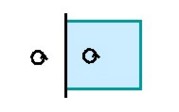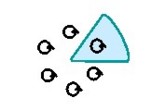Symmetries and periodicities: series or parallel connected coils
Reminder
As previously presented, the current value in a coil is set by means of the electric component the coil is associated to.
If several coils:
- are passed through by the same current (series connected coils), they can be assigned to the same component
- are passed through by different currents (parallel connected coils), they should be assigned to different components.
… in the presence of symmetries/periodicities?
In the presence of symmetries and/or periodicities, the “original” coils and the “copy*” coils, which are the result of symmetries and/or periodicities, are assigned to the same electrical component. Thus, they are passed through by the same current. That means the original and copy coils are series connected.
It is possible to modify this association of coils, and in particular, to connect coils or parts of coils in parallel by using the Conductors in series or in parallel option.
- real copies, in case of the non-meshed type coils, really represented outside the study domain, or
- virtual copies, in case of the meshed type coils. The virtual copies are not represented outside the study domain, but are taken into consideration by means of the boundary conditions
Example
Let us consider the two examples presented below. In the first example, the device has a symmetry, and the study domain represents only half of the device. In the second example, the device has a periodicity property and the study domain represents only a 1/6th of the device.
| Example |
Device having a symmetry property |
Devise having a periodicity property (60°) |
|---|---|---|
| Schema | 
|

|
In the two cases, the coil represented in the study domain is associated to only one electric component and a current value is set at the level of this component. Let this value be I. The value of the current in the coils (IC) according to the type of coils association carried out is given in the table below.
| Coils |
Device having a symmetry |
Device having a periodicity (60°) |
|---|---|---|
| all in series | IC = I | IC = I |
| all in parallel | IC = I/2 | IC = I/6 |